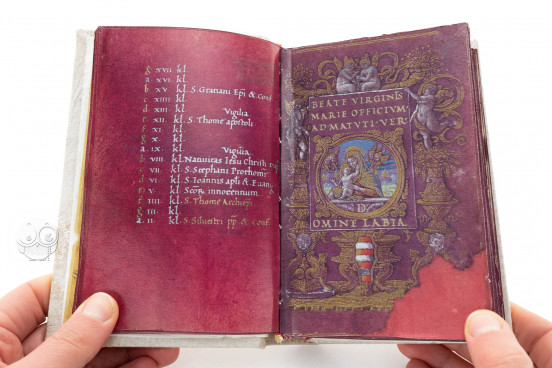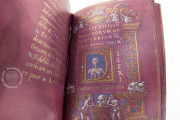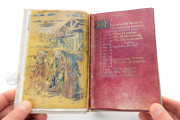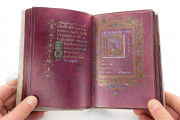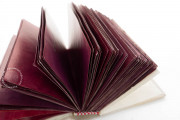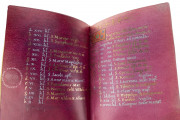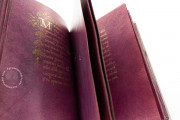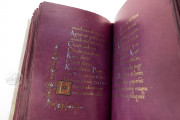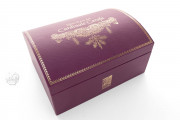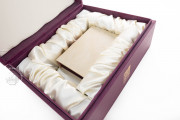The Hours of Cardinal Carafa is a Christian prayer book written entirely in gold and silver on purple-dyed parchment, a tour-de-force of luxury book production. It was written and illuminated by one of the most celebrated scribes of fifteenth-century Italy, Bartolomeo Sanvito, around 1470-1480 in Rome, presumably for Oliviero Carafa. Its illumination includes a full-page image of the Carafa family coat of arms and full-page miniatures of the Nativity of Christ and King David in Prayer.
The small volume comprises the prayer services of the Hours of the Virgin, the Office of the Dead, and the Hours of the Cross, as well as the seven Penitential Psalms, preceded by a liturgical calendar indicating saints and events to be commemorated on specific dates.
Drawing in Paint
The text pages of the manuscript are tinted purple, and the three pages with paintings are tinted ocher. Sanvito employed delicate hatching in the manner of pen and ink drawing in creating his figural compositions—the Nativity and David in Prayer. The figures (their faces, unfortunately, darkened over time) are expressive; even the faces of the ox and the ass adoring the Christ child seem to communicate tenderness (fol. 2v).
David Doubled
The Penitential Psalms are introduced by a full-page miniature showing David praying with his head tilted back and his eyes gazing to the sky (fol. 109v). He is being lifted out of the ground by two attendant angels, illustrating the opening words of one of the Penitential Psalms: "Out of the depths I cried to you, Lord." On the facing page, David is shown again, appearing less distressed and with his hands engaged in playing a psaltery to accompany his singing of the psalms (fols. 110r).
A Master of Humanistic Script
Sanvito wrote the manuscript's text in Humanistic Minuscule, one of the scripts for which his calligraphy was renowned. He wrote the main text in gold, with rubrics labeling the individual prayers and initial capital letters in silver. All eight services of the Hours of the Virgin and the other three text sections open with a historiated initial followed by a word or words in Square Capitals that imitate the appearance of ancient Roman inscriptions in stone. Many of the rubrics are in Rustic Capitals, the script used for literary texts in late antiquity.
Made for a Cardinal
The manuscript opens with a full-page image of the Carafa family coat of arms (fol. 1v) but without the cardinal's hat we would expect in a manuscript made for Oliviero Carafa (1430-1511), who became a cardinal in 1467. Nevertheless, Sanvito probably made the book for him given their shared connection with the papacy. The manuscript is preserved in its nineteenth-century binding with the arms of Pope Pius IX (1792-1878) and Cardinal Jean-Baptiste Pitra (1812-1889).
We have 1 facsimile edition of the manuscript "Hours of Cardinal Carafa": Libro d'Ore del Cardinale Carafa facsimile edition, published by ArtCodex, 2016
Request Info / Price

